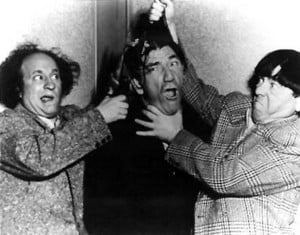Love them or hate them, the Three Stooges were one of the most underrated comedy teams of all time. And among the most underrated of the Stooges was Shemp Howard. Most people think of Shemp as the anemic replacement for Curly. After all, Curly had perfected signature lines and trademark moves 40 years before countless Saturday Night Live performers would attempt to do the same. Yet, despite Curly’s popularity, Shemp was one of the cornerstones of the Three Stooges.
Shemp’s Early Years
Shemp Howard was born on March 17, 1895 in Brooklyn New York. His given name was Schmool Horowitz, which was Anglicized to Samuel Howard. He was called Sam, but when his mother, with her thick European accent, called out his name, it sounded like Shemp and the nickname stuck.
Shemp was a mischievous child growing up, but by his early teens he’d outgrown most of his practical joking. Friends and family thought Shemp would grow up to be a comedian or actor, but Shemp had other plans and never seriously pursued acting, unlike his younger brother Moe who pursued his acting career with a vengeance.
Shemp dropped out of high school, along with younger brother Moe. Their mother insisted the boys pursue a trade since neither were in school. Shemp and Moe went to trade school. Shemp pursued plumbing. Moe studied to be an electrician. Neither of them finished trade school.
Although he tried, Shemp wasn’t a good student, he and Moe were very industrious. They worked hard doing odd jobs around the neighborhood. They delivered newspapers, tried setting up pins at the local bowling alley, even opened a plumbing business, but none of these careers stuck. This succession of jobs continued until young Shemp realized there was nothing left for them to do except try their hands at acting.
Shemp On Stage
Moe was already doing a stage act at local dance halls and amateur theater nights. Shemp joined Moe on stage, and the two decided to form an act. Neither one pursued comedy at this point. Moe had been pursuing a career in drama. Shemp had no theatrical experience. The brothers wrote a short skit and performed it at the local Bath Beach Theater. A few minutes into their performance they were literally thrown out of the theater – a rather inauspicious beginning. Shemp was discouraged, but Moe felt they had taken a big step. They were now performers. Bad ones to be sure, but at least they were gaining experience.
During World War I, Shemp and Moe switched to comedy. The two, particularly Shemp found that comedy came easily, naturally. In 1922, Shemp got his big break. One of Shemp’s old schoolmates, Ted Healy, had been doing well with a comedy routine. Healy needed a replacement in his act, which was being performed at the Brooklyn Prospect Theater. Moe and Shemp filled in and ad-libbed a routine that proved to be a big success. Healy took note and asked the brothers to join his act on a permanent basis. The act, Healy and his Stooges, was born.
As a result of this act, Shemp began to prosper on stage. He began performing in other productions in addition to his “stooge work.” In 1925, Shemp married Gertrude Frank, and two years later the couple gave birth to a son, Morton.
In 1927, Larry Fine joined the stooge act. The stooges at this point consisted of Ted Healy, the leader, Larry, Moe and Shemp. A typical routine consisted of Ted trying to deliver a comic monologue while Larry, Moe and Shemp cut up behind him and “ruining” Healy’s attempts at comedy.
In 1930, the act went to Hollywood to co-star in Rube Goldberg’s “Soup to Nuts.” Shortly after this, Larry, Moe and Shemp left Healy to form an act of their own called “The Lost Souls.” They met with limited success and rejoined Healy in 1932 to perform in a Broadway revue. Healy left the revue over a contract dispute taking Moe and Larry with him. Shemp declined to go with Healy and struck out on his own.
Nyuk Nyuk Nyuk
With Shemp’s departure the Healy’s act needed a third stooge. Moe suggested his kid brother, Jerome Howard, better known by his nickname, Curly. Meanwhile, Shemp was starring in two-reel comedies for Vitaphone and began to expand into feature films. He landed the role of Knobby Walsh in the famous Joe Palooka series. Meanwhile his brothers were also doing well. The Three Stooges, with Curly as the third Stooge, were a comic staple for Columbia Pictures.
Shemp — The Night Club Owner
Times were good for Shemp and his wife. In 1937, Shemp opened a nightclub, Stage One. He was under contract to do a comedy series at Columbia and worked in feature films for RKO and MGM. Shemp worked alongside Abbot and Costello, W.C. Fields, John Wayne and Broderick Crawford.
Shemp entertained regularly at his North Hollywood home. Shemp had many friends in the Hollywood acting community. Occasionally Moe and Curly would drop by with their wives. But Moe’s circle of friends didn’t include many celebrities. Moe’s circle included judges, lawyers, prominent businessmen and so forth. Moe was always up on current affairs, news, politicas and such. Shemp was more laid back. He liked the simple life. He’d often be found fishing with his son or listening to music with his wife.
Shemp Rejoins the Stooges
When Curly had a stroke, Shemp reluctantly rejoined the Three Stooges. His career was doing well, and he hesitated before joining. He wanted to make sure that his work as a stooge was only temporary until Curly recovered from his stroke and could resume work. Unfortunately Curly’s condition worsened. He died in 1952. Part of Shemp’s reluctance may have been that he knew he was replacing the most popular stooge. Curly was a tough act to follow.
Shemp acted in 73 Three Stooges shorts until his death from a sudden heart attack on November 22, 1955.
Shemp’s Legacy
It’s hard to use the words Shemp and legacy together without smiling. But that is Shemp’s legacy. Shemp Howard, the underrated stooge, brought smiles to millions.



